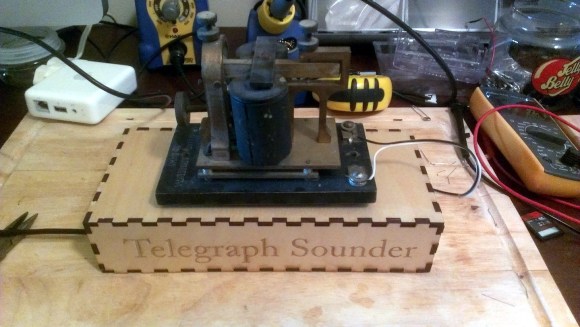
[Patrick Schless] is excited to show off the project he took on about nine months ago. After finding an antique telegraph sounder he wired it up to an Arduino to see if he could make it tick. The successful experiment laid the ground work for different hardware that would make it into a morse code email reader.
He doesn’t know much about the background of the old hardware, but driving it is relatively simple. It’s basically a magnetic relay so you need to have a transistor for switching and a flyback diode for protection. Once those components are in place it’s just a matter of toggling a bit. [Patrick] knew he wanted to pull messages from an online source, so he set his Arduino aside and grabbed a Raspberry Pi. It worked like a charm. His plan was to put this on a bookshelf in perpetuity so he went the extra mile, designing his own PCB and having it spun using the OSH Park service. The project is finished with this low-profile laser-cut base which houses all of the electronics.
Now if he wants to respond to his emails in Morse code he needs to build this keyboard.















-. . .- –
.–. — .. -. – .-.. . … …
Morse code posts periodically send me back here to see if anyone posted anything more about the “Morse code USB slide keyboard”.
ahhh my eyes!
(it would be nice to have the aspect ratio of the photos preserved, at least)
“When I got the first batch, a few components didn’t fit right”
Mistakes like these can be easily avoided by printing out the board layout on a piece of paper, and placing the components on top.
.– …. -.– / .- .-. . / .– . / ..- … .. -. –. / — — .-. … . / -.-. — -.. . ..–..
Isn’t the mark space of telegraphic Morse different than CW Morse, as well as several characters. A click has no length only the space, sort of like a negative version. A ham should be unable to read this.
Has anyone heard the Motel 6 commercial on radio where Tom Bodette says ” you could book a room by pigeon but you’ll be … — .-.. ,(SOL)!